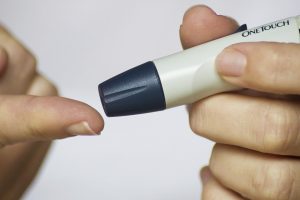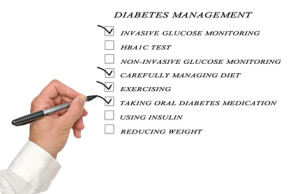Live Life First, Be Diabetic Second, and Stay Active
The secret to my overall success, both professional and personal, is that I made a conscious choice to live my life by one guiding principle: Live life first, and be diabetic second.
Lost your password? Please enter your email address. You will receive a link to create a new password.

The secret to my overall success, both professional and personal, is that I made a conscious choice to live my life by one guiding principle: Live life first, and be diabetic second.

There is plenty of news in the media which says that the COVID-19 is harmless for a healthy individual. They also mention that people with underlying conditions are sensitive to the disease. One such underlying condition that many have is Type 2 Diabetes Mellitus. According to sources, Tom Hanks testing positive for COVID-19 caused panic… that was because this popular actor is also a Type-2 diabetic.
 Why are Diabetic People More in Danger?
Why are Diabetic People More in Danger?A healthy person and a diabetic person are at the same risk of catching the infection. The difference is how the patients deal with the virus. A diabetic patient has a higher chance of facing complications. A person with diabetes will face severe symptoms if they get COVID-19. Diabetes fluctuates the level of glucose in your body. Because of this, diabetic people with COVID-19 have severe inflammation and swelling.
Being a diabetic or the caregiver of such a patient will be stressful for you. Social distancing is the only you can avoid getting the disease. In case you are wondering how to practice social distancing here are a few tips:
The government suggests shielding advice to all diabetic patients. It meant that all people vulnerable to the disease stay at home for almost 12 weeks. During this period, you should avoid all face-to-face contact. You must understand the risks that you are putting yourself into if you do not take precautions.
Terrance Hutchinson is the Owner of Your Best Lifestyles Fitness and Nutrition. He is a Certified Personal trainer specializing in Exercise Therapy, Corrective Exercise, Sports Nutrition, and Corporate Wellness. He an author of 3 books, he has his own podcast, he has contributed articles to major newspapers and magazines, Terrance has spoken at health events, webinars, seminars, hospitals, schools, doctors offices and has been featured nationally syndicated television platforms. Terrance has clients in many states and counties and is looking to help others bridge the gap between the medical and fitness industries. To learn more about Terrance, visit yourbestlifestyles.com

Given that in the United States alone, there are close to 30 million people who have diabetes and five to 10 percent of those have type 1 diabetes (and must use insulin), many of your clients may be insulin users…


According to the American College of Sports Medicine’s flagship journal, Medicine and Science in Sports and Exercise (1), there are more than 21 million Americans with Type 2 Diabetes as of 2010 with an estimated 7 million undiagnosed. If these numbers don’t mean much, let’s give it some perspective: in 1958 there were only 1.5 million. (Granted, the US population has increased, but only from about 180 million to 310 million, not 15-fold as in the numbers of T2D.) Furthermore, due to the now-defined pre-diabetes – or sub-clinical diabetes where the precursors to diabetes are lurking if lifestyle does not change dramatically – it is estimated that 80 million Americans are at risk. Thus, some public health officials are predicting that 21-33% of Americans will have diabetes by the year 2050. The healthcare burden this portends will bankrupt the nation. To make matters worse, the preponderance of both pre-diabetes and T2D is increasing in children and adolescents as sedentary behavior, poor diet and obesity abounds.
While prevention is optimal and much is being done in the way of public health messaging, one of the best means by which to regulate blood sugar in either healthy, pre-diabetes or T2D patients is through physical exercise. Recall above where we discussed how muscles use the sugar in the blood for fuel. The more muscles you have and the more regularly they work at some critical level of effort, the easier it is to control blood sugar. In fact, one’s levels of physical activity (PA) may be a better predictor of risk for diabetes than one’s BMI (body mass index, a ratio of height to weight.)
For the sake of discussion, we should break down physical activity into three main types – activities of daily living (ADL), aerobic exercise (AE) and resistance (or strength) exercise (RE). The MSSE article reviewed the data on all these for their impact on blood sugar, insulin control and T2D risk. Not unremarkably, the evidence strongly suggests that the more active you are, the lower your post-meal and long-term blood sugar is, the better your muscles are able to use the sugar in the blood (glucose tolerance or insulin sensitivity), the lower or lesser your insulin response is to food intake, and the lower your risk for diabetes is. What is remarkable, however, is how little physical activity is required in order to affect many of these changes and benefits.
As far as ADLs is concerned, the general prescription is to ambulate (walk, run, bike, etc) for 30-60 minutes a day or close to 10,000 steps/day, or almost 4 miles/day. This does not mean you have to take walks that last that long; it means you should move around more often throughout the day and sit less often. In fact, some studies show that simply standing up for 2 minute bouts of walking every 20 minutes of sitting lowered post-meal blood sugar and insulin response to eating. (2) While walking is effective, new studies (3) demonstrate that high intensity interval training (HIIT), or sprinting, may be an even better regulator of blood sugar. Comparing training programs in two groups of sedentary women, one doing intervals of moderate intensity, the other at high intensity, the authors found that the HIIT group had slightly greater fat oxidation in the muscles, a roundabout indicator of improved glucose control. HIIT might also be more time efficient.
Between the two studies referenced here, and many more that have looked at HIIT programs compared to traditional long, slower/lower intensity programs, the general belief is that the more muscles that are contracting and the harder they contract, the better the short-term and long-term blood sugar control. The only caveat here is that large muscle groups or bigger body movements are necessary to see these effects; single joint/small muscle contractions will not elicit the disease-modifying effects one might be seeking. For these reasons, RT has been getting more looks when it comes to modifying risk factors for T2D. In fact, the preponderance of evidence shows that RT, at sufficiently high enough intensities to build muscle mass, improves blood sugar control both by using sugar to fuel contractions and by improving the insulin sensitivity of those muscles even after the workouts.

Overall, physical activity has been shown to be an effective, efficient and low-risk/low side-effects treatment and preventive for T2D. A single bout of exercise is sufficient to regulate blood sugar for the next 16-24 hours.
As such, it is recommended that exercise be partaken nearly every day for at least 30 minutes; if obesity is a factor in a patient’s disease, then 60-90 minutes of accumulated physical activity is strongly suggested. Furthermore, a combination exercise prescription of cardiovascular and RT exercise – either same or alternating days – is deemed optimal.
To conclude, physical activity of all sorts has been found to enhance blood sugar uptake by muscles during the session and for several hours thereafter. Thus, it is one of the best, least invasive means by which to prevent, regulate and, for early stage T2D, even reverse diabetes and its downstream effects on the heart, kidneys, nerves (especially of the lower extremities), and eyes. Besides its collateral benefits on the cardiovascular system, it may help reduce weight though it is essential in maintaining weight loss. And PA clearly improves quality of life, not just through its physical benefits but its effects on the brain and psyche, reducing the risk of depression which may be a factor in both the sequence of events leading to weight gain, the challenges of both weight loss and disease management, and the reduction in one’s ability to enjoy various aspects of life due to immobility, neuropathy, visual impairment, and dialysis.
For more information about diabetes, exercise, pharmaceutical management and research, please visit the American Diabetes Association site at diabetes.org
Dr. Irv Rubenstein graduated Vanderbilt-Peabody in 1988 with a PhD in exercise science, having already co-founded STEPS Fitness, Inc. two years earlier — Tennessee’s first personal fitness training center. One of his goals was to foster the evolution of the then-fledgling field of personal training into a viable and mature profession, and has done so over the past 3 decades, teaching trainers across through country. As a writer and speaker, Dr. Irv has earned a national reputation as one who can answer the hard questions about exercise and fitness – not just the “how” but the “why”.
References
1. Roberts et al, Modification of Insulin Sensitivity and Glycemic Control by Activity and Exercise. MSSE, Vol. 2013: 45(10):1868-1877
2. Dunstan et al., Breaking up prolonged sitting reduces glucose and insulin responses. Diabetes Care, 2012:35(5): 976-983
3. Astorino et al., Effect of Two Doses of Interval Training on Maximal Fat Oxidation in Sedentary Women. MSSE, Vol. 45(10), pp.1878-1886, 2013


Personal trainers have the opportunity to do more than just help people they train become more active. We need to be prepared to also help our clients implement lifestyle behavior changes related to stress, family history of coronary heart disease, obesity, smoking, high blood pressure and high cholesterol.
A look at what is called metabolic syndrome will help you understand why, even though increasing physical activity levels is the overall best thing you can do for any client, there are additional ways to guide them to a healthier lifestyle. Sometimes you may be able to help them make the changes yourself; and, sometimes you will need to refer them to another health professional like a doctor or dietitian for guidance. Either way, knowing how to help them or when to direct them to someone who is more knowledgeable than you is important. So, first let’s become familiar with the syndrome and the clinical criteria that the doctor uses to diagnose it. Your goal is then to help your clients understand and make the necessary changes so that they don’t progress to cardiovascular disease and the almost certain heart attack heart that will be the end result.
Cardiovascular disease is still the number one cause of morbidity and mortality in the United States and much of this burden of disease can be linked to poor nutrition and a dramatic increase in sedentary lifestyles, leading to overweight and obesity. This increase in weight leads to an increase in the incidence of type 2 diabetes, and blood pressure and cholesterol problems, which are all well-established cardiovascular disease risk factors. The National Cholesterol Education Program (NCEP) Adult Treatment Panel (ATP) III has updated the recommendations for the evaluation and management of adults dealing with high cholesterol, renewing its emphasis on the importance of lifestyle modifications for improving cardiovascular risk. The NCEP has coined the term “therapeutic lifestyle changes” (TLC) to reinforce both dietary intake and physical activity as crucial components of weight control and cardiovascular risk management.
As well as focusing attention on the LDL cholesterol (also called bad cholesterol) levels, the NCEP also identified metabolic syndrome as a secondary target of therapy. Metabolic syndrome (also called insulin resistance syndrome and syndrome X) is characterized by decreased tissue sensitivity to the action of insulin (pre-diabetes), resulting in a compensatory increase in insulin secretion. This metabolic disorder predisposes individuals to a cluster of abnormalities that can lead to such problems as type 2 diabetes, coronary heart disease and stroke. The prevalence of the syndrome has increased 61% in the last decade. It is crucial for medical professionals to identify patients at risk and follow these patients closely and counsel them about making lifestyle changes to lower the risk of type 2 diabetes and cardiovascular disease.
| Risk factor | Defining level |
| Abdominal obesity Men Women |
Waist circumference >40 in (>102 cm) >35 in (>88 cm) |
| Fasting triglyceride level | >150 mg/dL |
| HDL cholesterol level Men Women |
<40 mg/dL <50 mg/dL |
| BP | >130/>85 mm Hg or taking antihypertensive medication |
| Fasting glucose level | >100 mg/dL or diabetes |
Source: Expert Panel on Detection, Evaluation, and Treatment of High Blood Cholesterol in Adults. Executive Summary of the Third Report of the National Cholesterol Education Program (NCEP) Expert Panel on Detection, Evaluation, and Treatment of High Blood Cholesterol in Adults (Adult Treatment Panel III). Bethesda, Md: National Institutes of Health; 2001. NIH publication 01-3670.
 Millions of Americans at risk for metabolic syndrome can sharply lower their chances of getting this disease by adopting a healthy lifestyle (stop smoking, low-fat diet, weight loss/maintenance and increased physical activity). Without diet and exercise modifications, most patients will eventually fail and progress to type 2 diabetes within a decade and experience a heart attack about 10 years later. Experts recommend a diet reduced in saturated fats (<7%), low in cholesterol (<200 mg/day), high in fiber (20-30gm/day) and reduced in simple sugars. Weight loss of only 5-7% (less than 15 pounds) can make a big difference in health markers like cholesterol and blood pressure. A program that includes daily exercise reaching 85% of heart rate for age is reported to be of benefit too. However, any exercise is better than none, and a target of 30 minutes every other day is a reasonable level for most people.
Millions of Americans at risk for metabolic syndrome can sharply lower their chances of getting this disease by adopting a healthy lifestyle (stop smoking, low-fat diet, weight loss/maintenance and increased physical activity). Without diet and exercise modifications, most patients will eventually fail and progress to type 2 diabetes within a decade and experience a heart attack about 10 years later. Experts recommend a diet reduced in saturated fats (<7%), low in cholesterol (<200 mg/day), high in fiber (20-30gm/day) and reduced in simple sugars. Weight loss of only 5-7% (less than 15 pounds) can make a big difference in health markers like cholesterol and blood pressure. A program that includes daily exercise reaching 85% of heart rate for age is reported to be of benefit too. However, any exercise is better than none, and a target of 30 minutes every other day is a reasonable level for most people.
As a fitness professional reading this, hopefully you are not asking yourself “so what?” but are instead seeing an opportunity to educate and motivate your current clients and to use your knowledge to help attract future clients. The medical community is good at diagnosing this syndrome, but not necessarily equipped to provide patients with the tools to be successful with the lifestyle changes they recommend. There exists a wonderful opportunity to build a partnership with physicians in your area. Most physicians will gladly refer patients to you for help with the all-important exercise and nutrition portion of the treatment program. In many cases, you have more knowledge in this area than the physician who has been trained in tertiary, not preventative, (i.e. most MD’s know very little about diet and exercise since this is not a focus in medical school) medicine. Often times all that you will need to get a referral is for the doctor to be aware of your existence and to give them an easy way to get the patient to you. A short introduction letter outlining your qualifications and showing your desire to help people make lifestyle changes is a good start. A personal visit to your primary care doctor and others in your area is even better. But, be prepared to take up just a few minutes of their time to introduce yourself, your idea, and leave your letter and cards.
Tammy Petersen, MSE, is the Founder and Managing Partner for the American Academy of Health and Fitness (AAHF). She’s written a book on older adult fitness and designed corresponding training programs. SrFit Mature Adult Specialty Certification is used nationwide as the textbook for a college based course for personal trainers who wish to work with mature adults. SrFit is also the basis for a specialty certification home study course that qualifies for up to 22 hours of continuing education credit with the major personal trainer certification organizations.
References

According to statistics, in 2014, 8.5% of adults above 18 years old had diabetes. Sadly, the disease is also affecting the youths below the age of 20. Basically, what this means is the chances of getting the disease are becoming higher for everyone. Eating healthy and maintaining a good exercise routine are often thought of as preventive measures but the truth is they can work wonders even if you have been diagnosed.
 In this article, we will discuss some simple tips on how you can run safely with diabetes. There is no reason for you to quit running just because you have the condition. In fact, being able to lose weight with running can contribute to your general health.
In this article, we will discuss some simple tips on how you can run safely with diabetes. There is no reason for you to quit running just because you have the condition. In fact, being able to lose weight with running can contribute to your general health.
You simply have to take a few more things into consideration before you hit the road. First off, you need to understand the needs of your body depending on the type of diabetes you have.
Type 1 diabetes is basically when the pancreas does not produce enough insulin and the sufferer requires daily insulin injections. The condition is not curable and symptoms include excessive urine, constant hunger, thirst, weight loss, and fatigue.
Those suffering from type 1 diabetes face the risk of getting fatigued after extended periods of running. You will need to constantly monitor your sugar levels during the run and make sure they stay normal. This is one of the most important steps you ought to take: understand how your body reacts to exercise and fueling.
Once you understand your body’s reaction, you may opt to use a GU energy gel after every 15 minutes to fuel their runs. However, before making any decisions, consult your physician and get their advice first. When it comes to fueling, runners generally require 30-60 grams of carbohydrates every hour but this depends on your insulin levels.
Type 1 diabetes sufferers need to always remember that the blood glucose response to exercise will vary depending on these factors:
Basically, through trial and error, you will be able to come up with a system of insulin intake and fueling that works for you.
Type 2 diabetes is the most common type of diabetes and happens when your body does not properly use insulin-making your body “insulin resistant”. Initially, your pancreas produces extra insulin but in time it isn’t enough to keep your sugar levels normal.
The symptoms are very similar to Type 1 diabetes and include weight loss, increased thirst, and frequent urination, fatigue, blurred vision and slow healing sores.
The benefit of running even with diabetes Type 2 is that, your muscles use glucose during exercise which means your glucose levels go down. There are also many long-term benefits of running with Type 2 diabetes such as lowered risk of heart problems.
Like Type 1 diabetes, you will need to constantly monitor your blood glucose levels during exercise and fuel accordingly. The same suggestions provided for Type 1 Diabetes can be applied to Type 2 diabetes.
Whichever Type of diabetes you are diagnosed with, there are some general rules you can follow to make sure you are safe during your runs. Of course, consulting your physician should always be on top of the list, after you do this, remember these five tips:

This is true even if you have been running for a long time in the past. Remember that your body is different now and you need to understand it all over again. Instead of running a sprint immediately, gradually ease into it. Try walking for an hour, then upgrade to a brisk walk, then combine walking and jogging and finally try a short run.
According to one study, increased muscle mass attained as a result of strength training can contribute to blood glucose absorption thereby lowering the levels in the blood. This, in turn, can increase insulin sensitivity. You don’t have to go to the gym to lift weights but even workouts such as squats, push-ups, and lunges that use your own body weight can be done at home.
This is another great aid to running with diabetes safely. Find a running buddy who knows your condition and knows what to do if your blood sugar gets too low. Another option is to carry an identification tag with you that says that you have diabetes.
Although this applies to everyone who runs, it is more serious if you have diabetes. Wearing the wrong kind of footwear could lead to getting foot ulcers. With diabetes, even the slightest blister could take a long time to heal and lead to many more complications such as gangrene.
When purchasing footwear, take into consideration the shape of your foot and whether you have foot deformities such as bunions. If you do have any kind of foot deformity, you might need special inserts or specially made therapeutic shoes.
A lack of water can greatly affect blood sugar levels so before you run, make sure you are fully hydrated and continue to hydrate during your run.
Running with diabetes is possible. You just have a checklist that is a little longer and a body that has different needs. Don’t let diabetes be the end of your running career! Remember that there are thousands of runners who continue to run marathons with the condition and you can do the same.
Amber Irwin is a running and sports writer; she loves to share her passion with fellow outdoor lovers. Amber believes running is an amazing sport for everyone and hopes to inspire others. Visit her website, everyfirststep.com
References
http://www.who.int/mediacentre/factsheets/fs312/en/
http://www.diabetes.org/diabetes-basics/statistics/
https://www.mayoclinic.org/diseases-conditions/type-1-diabetes/symptoms-causes/syc-20353011
http://www.diabetes.org/diabetes-basics/type-2/
https://www.mayoclinic.org/diseases-conditions/type-2-diabetes/symptoms-causes/syc-20351193
https://www.endocrineweb.com/conditions/type-2-diabetes/type-2-diabetes-exercise

 Unfortunately, diabetes is becoming a common disease in the United States and elsewhere. Some of that is genetic since you are at a higher risk if your parents had the disease, but an unhealthy lifestyle can contribute to it as well.
Unfortunately, diabetes is becoming a common disease in the United States and elsewhere. Some of that is genetic since you are at a higher risk if your parents had the disease, but an unhealthy lifestyle can contribute to it as well.
When you received your diagnosis of diabetes, you had to make some immediate changes to keep your blood sugar in check. Taking prescriptions and insulin will help, but there are some things you can do right at home to stay healthy and keep your glucose levels in the right zone. But do you know exactly why that’s so important?
How do you know if your diabetes isn’t under control? The best way is through your testing kit. That’s why you need to regularly test your blood glucose level. But Everyday Health lists some other signs of uncontrolled diabetes you should be on the lookout for:
Is having such high blood sugar that bad? You know that the long-term effects include vision loss and losing sensation in your feet, but those are so drastic that it can be hard to accept them as real. Here are some other problems that come from uncontrolled diabetes:
With all that can go wrong with uncontrolled diabetes, it’s not hard to see why you need to work on keeping your blood sugar in check. Besides taking prescriptions as ordered, you can do this by making some changes to your diet.
One of the most obvious is lowering the number of carbs you eat. That can be hard, especially since sugar and carbohydrates are addictive. Healthline.com has a great list of ways you can reduce your carbohydrates at home:
But eating well means more than cutting back on carbs. Here are some other tips for a diabetic-friendly diet:
 Exercising With A Home Gym
Exercising With A Home GymBesides eating better, you need to get some exercise. Not only will this help reduce your blood sugar levels, it can keep your body healthy — and diabetics need that more than others. But you don’t have to buy an expensive gym membership. In fact, you can create a gym in your own home. Redfin explains there are a few home gym essentials to focus on, including:
In addition, look into apps and devices like Fitbits to help keep you motivated by seeing the results of your efforts.
Having diabetes is annoying, but there are many ways you can keep your blood sugar under control. Know the signs of high blood sugar, and make some smart choices with your diet. Then start exercising at home. This way, you can stay healthy for many years to come even with diabetes.

Do you have type 1 diabetes, type 2 diabetes, or prediabetes? Then you need to know that exercise is a cornerstone in the management of all of these conditions, and it can benefit your health in so many ways.
 Sometimes, being active can actually make it more challenging for you to manage your blood glucose (“blood sugar”) levels, unless you learn more about its effects. I have always known at some level that exercise generally did good things for my blood glucose, even before I had my first blood glucose meter (after going 18 years without access to one). How could I tell without a blood glucose meter?
Sometimes, being active can actually make it more challenging for you to manage your blood glucose (“blood sugar”) levels, unless you learn more about its effects. I have always known at some level that exercise generally did good things for my blood glucose, even before I had my first blood glucose meter (after going 18 years without access to one). How could I tell without a blood glucose meter?
Being active always made me feel better, physically and emotionally, so much so that I earned a PhD in Exercise Physiology to understand why. You don’t need to go that far with your education, but there are some basics about being physically active with diabetes or prediabetes that you really need to know.
Here are some things that I know about exercise now that I wish someone had told me years ago.
#1: Exercise can help erase your blood glucose “mistakes”
#2: Exercise doesn’t always make your blood glucose go down
 Over a longer period of time (2-3 hours), it usually comes back down, but who wants to wait that long?
Over a longer period of time (2-3 hours), it usually comes back down, but who wants to wait that long?#3: Your muscles are critical to managing your blood glucose levels
#4: Exercise is the best medicine there is
For other tips on exercise and more, visit www.diabetesmotion.com or www.shericolberg.com. You can also find some exercise programs geared towards people with diabetes by visiting Diabetes Motion Academy (www.DMAcademy.com).
Sheri R. Colberg, PhD, FACSM, is a Professor Emerita of Exercise Science at Old Dominion University and a former Adjunct Professor of Internal Medicine at Eastern Virginia Medical School. She is an internationally recognized authority on diabetes and exercise.

Managing Diabetes can be very complex. How can the diabetes patient be successful at creating a solid lifestyle plan involving healthy nutrition, increased activity and effective medical management? A study published by American Diabetes Association, Clinical Diabetes, state’s “Controlling diabetes to reduce the incidence of its complications rests largely on individual patients and requires vigorous self-management of the disease. Unfortunately, without sustained support, few people achieve their goals or master the tasks that will allow them to live healthfully and reduce their risk of costly complications.”
 According to the New England Journal of Medicine, “Type 2 diabetes is increasingly common, primarily because of increases in the prevalence of a sedentary lifestyle and obesity. It was concluded that the reduction in the incidence of diabetes was directly associated with changes in lifestyle and that Type 2 diabetes can be prevented by changes in the lifestyles of high-risk subjects.”
According to the New England Journal of Medicine, “Type 2 diabetes is increasingly common, primarily because of increases in the prevalence of a sedentary lifestyle and obesity. It was concluded that the reduction in the incidence of diabetes was directly associated with changes in lifestyle and that Type 2 diabetes can be prevented by changes in the lifestyles of high-risk subjects.”
Diabetes self-management can be very overwhelming for the diabetic patient often leading to a sense of failure but there is help. A Health & Wellness Plan created together with a coach has proven to increase success in achieving healthier lifestyle behaviors and a greater quality of life.
While diabetes management can be overwhelming the Clinical Diabetes study results “revealed broad agreement among participants that their coach helped them figure out what to do to better control diabetes, that their coach’s encouragement was important in controlling diabetes, and that coaching was an important part of the overall program.”
Studies performed by Duke University, published by the New England Journal of Medicine, and the American Journal of Lifestyle Medicine suggest that working with a Health Coach improves medical management, patient engagement, social support, physical activity, diet, decreases stress, and reduces A1C scores. In addition, patient perception indicated positive improvements in overall personal health status, as well as, accomplishment of their goals when working with a health coach.
The Affordable Care Act recognizes that focusing on wellness and prevention is key to improving the health of Americans. The National Prevention Strategy is moving us from a system of sick care to one based on wellness and prevention. Many of the programs and initiatives now being funded include coaching. An example is the YMCA Diabetes Prevention Program that now includes Health Coaches within their team. We are now also finding coaches within insurance companies, such as UnitedHealth Group, Optima Health and Aetna due to success in improving diabetes control for the patient.
 What Can Health & Wellness Coaches Do for You?
What Can Health & Wellness Coaches Do for You?Coaches work with diabetes patients in a variety of ways. In one example of coaching in a healthcare setting Dr. Heather Bennett and her team (in an American Academy of Family Physicians publication) described Health Coaching for patients as encompassing five principal roles:
In Bennett’s model the role of health educator and the role of health and wellness coach was combined.
Providing self-management support
Self-management support is essential for patients to extend their health care outside the clinic walls and into their real lives. Coaches assist patients in seven domains of self-management support: providing information, teaching disease-specific skills, promoting healthy behaviors, imparting problem-solving skills, assisting with the emotional impact of chronic illness, providing regular follow-up and encouraging people to be active participants in their care. Patients have better health outcomes when provided with disease-specific knowledge and skills.
Bridging the gap between clinician and patient
Throughout the care process, there are plenty of opportunities for disconnects between the clinician and the patient. Prescribing medications is one example. It is a two-part endeavor: 1) writing prescriptions and 2) making sure patients obtain, understand and actually take the medications as prescribed. Physicians perform part one but lack time to address the critical second part. Health coaches can bridge these gaps by following up with patients, asking about needs and obstacles, and addressing health literacy, cultural issues and social-class barriers. Health Coaches help patients navigate the health care system. Many patients, particularly the elderly, disabled and marginalized, need a navigator to help locate, negotiate and engage in services. Coaches can help coordinate care and advocate with patients when their voices are not heard.
Offering emotional support
Coping with illness is emotionally challenging. Well-intentioned but rushed clinicians may fail to address patients’ emotional needs. As trust and familiarity grow, coaches can offer emotional support and help patients cope with their illnesses. They also assist patients in seeking out additional emotional support that will help them achieve and maintain success.

Serving as a continuity figure
Coaches connect with patients not only for office visits but also between visits, creating familiarity and continuity. This is particularly helpful in practices where clinicians work part-time or see one another’s patient. Coaches travel with the patient as an ally and assist them with staying the course while implementing their wellness plan.
Coaches facilitate a patient-directed process of evaluation and assessment, exploration, tracking and accountability to and assist in co-creating a plan that is tailored to the patient Health & Wellness Coaches work with a patient individually or in small groups. They help create a whole-life integrated wellness plan toward managing diabetes and bringing about the lifestyle changes needed for a healthier life. Coaches serve as an ally to help those challenged with diabetes follow through with their health & wellness plan so they can achieve their goals toward their best life possible.
References
Affordable Care Act – Department of Health & Human Services: www.hhs.gov
Bennett et al, Health Coaching for Patients With Chronic Illness. Fam Pract Manag. 2010 Sep-Oct;17(5):24-29.
MacLean et al, Telephone Coaching to Improve Diabetes Self-Management for Rural Residents. Clinical Diabetes. January 2012 vol. 30 no. 1 13-16.
Melko et al, American Journal of Lifestyle Medicine, March/April 2010; vol. 4, 2: pp. 187-194.
National Prevention Strategy, Clinical and Community Preventive Services, National Prevention Council 2010. www.surgeongeneral.gov/initiatives/prevention/strategy/preventive-services.pdf
National Prevention Council Action Plan: Implementing the National Prevention Strategy
www.surgeongeneral.gov/initiatives/prevention/2012-npc-action-plan.pdf
National Prevention Council, National Prevention, Health promotion, and Public Health Council, 2013 Annual Status Report. June 25, 2012. http://www.cdc.gov/features/PreventionCouncil
Sacco et al, Effect of a brief, regular telephone intervention by paraprofessionals for type 2 diabetes. Journal of Behavorial Medicine. August 2009, Volume 32, Issue 4, 349-359.
Tuomilehto et al, Prevention of Type 2 Diabetes Mellitus by Changes in Lifestyle among Subjects with Impaired Glucose Tolerance .N Engl J Med 2001; 344:1343-1350.
Wolever et al, Integrative Health Coaching for Patients With Type 2 Diabetes A Randomized Clinical Trial. The Diabetes Educator July/August 2010 vol. 36 no. 4 629-639.